Development of a Smartphone-Based University Library Navigation and Information Service Employing Wi-Fi Location Fingerprinting
Abstract
1. Introduction
2. Suitable Indoor Positioning Techniques Survey
2.1. General Aspects
2.2. Technological Requirements
2.3. Compendium of Common Technologies
2.4. Range-Based Localization Operational Principle
2.5. Location Fingerprinting
2.6. Specifics of Wi-Fi Positioning
3. Test Site and Measurement Procedures
3.1. Test Site
3.2. Wi-Fi Signal Availabilities
3.3. Test Measurement Procedures
4. Analyses of the Off-Line System Training Phase
4.1. Measurement Mode Comparison
4.2. Radio Map Generation
4.3. Visibility and Range of the Wi-Fi Signals
4.4. Kinematic System Training
5. Impact of Different Scan Durations on the Positioning Results
6. Localization in the On-Line Positioning Phase
6.1. Probabilistic Fingerprinting Approach
6.2. Static Positioning
6.3. Kinematic Positioning
6.4. Cramér-Rao Lower Bound
6.5. Disscussion and Proposal for Performance Improvement
7. Path towards the Development of a Library Navigation and Information System
8. Concluding Remarks and Outlook
Author Contributions
Funding
Institutional Review Board Statement
Informed Consent Statement
Data Availability Statement
Conflicts of Interest
References
- Retscher, G. Fundamental concepts and evolution of Wi-Fi user localization: An overview based on different case studies. Sensors 2020, 20, 5121. [Google Scholar] [CrossRef] [PubMed]
- Chen, R.; Pei, L.; Liu, J.; Leppäkoski, H. WLAN and Bluetooth positioning in smart phones. In Ubiquitous Positioning and Mobile Location-Based Services in Smart Phones; IGI Global: Hershey, PA, USA, 2012; pp. 44–68. [Google Scholar]
- Liu, H.; Darabi, H.; Banerjee, P.; Liu, J. Survey of wireless indoor positioning techniques and systems. IEEE Trans. Syst. Man Cybern. Part C Appl. Rev. 2007, 37, 1067–1080. [Google Scholar] [CrossRef]
- Ali, W.H.; Kareem, A.A.; Jasim, M. Survey on wireless indoor positioning systems. Cihan Univ. Erbil Sci. J. 2019, 3, 42–47. [Google Scholar] [CrossRef]
- Youssef, M.; Agrawala, A.; Shankar, A.U. WLAN location determination via clustering and probability distributions. In Proceedings of the First IEEE International Conference on Pervasive Computing and Communications (PerCom 2003), Fort Worth, TX, USA, 23–26 March 2003. [Google Scholar]
- Sakpere, W.; Adeyeye-Oshin, M.; Mlitwa, N.B. A state-of-the-art survey of indoor positioning and navigation systems and technologies. S. Afr. Comput. J. 2017, 29, 145–197. [Google Scholar] [CrossRef]
- Want, R.; Hopper, A.; Falcao, V.; Gibbons, J. The Active Badge location system. ACM Trans. Inf. Syst. 1992, 10, 91–102. [Google Scholar] [CrossRef]
- Yi, K.Y.; Kim, D.Y.; Yi, K.M. Development of a Localization System based on VLC technique for an indoor environment. J. Electr. Eng. Technol. 2015, 10, 436–442. [Google Scholar] [CrossRef]
- Akiyama, T.; Sugimoto, M.; Hashizume, H. Time-of-Arrival-based smartphone localization using Visible Light Communication. In Proceedings of the International Conference on Indoor Positioning and Indoor Navigation (IPIN 2017), Sapporo, Japan, 18–21 September 2017. [Google Scholar]
- Jung, S.-Y.; Hann, S.; Park, C.-S. TDOA-based optical wireless indoor localization using LED ceiling lamps. IEEE Trans. Consum. Electr. 2011, 57, 1592–1597. [Google Scholar] [CrossRef]
- Brena, R.F.; García-Vázquez, J.P.; Galván-Tejada, C.E.; Muñoz-Rodriguez, D.; Vargas-Rosales, C.; Fangmeyer, J. Evolution of indoor positioning technologies: A survey. J. Sens. 2017. [Google Scholar] [CrossRef]
- Moutinho, J.; Araújo, R.; Freitas, D. Indoor localization with audible sound—Towards practical implementation. Pervasive Mobile Comput. 2016, 29, 1–16. [Google Scholar] [CrossRef]
- Li, J.; Han, G.; Zhu, C.; Sun, G. An indoor ultrasonic positioning system based on TOA for Internet of Things. Mobile Inf. Syst. 2016, 1–10. [Google Scholar] [CrossRef]
- Nakashima, Y.; Kaneto, R.; Babaguchi, N. Indoor positioning system using digital audio watermarking. IEICE Trans. Inf. Syst. 2011, 94, 2201–2211. [Google Scholar] [CrossRef]
- Lopes, S.I.; Vieira, J.M.N.; Reis, J.; Albuquerque, D.F.; Carvalho, N.B. Accurate smartphone indoor positioning using a WSN infrastructure and non-invasive audio for TDoA estimation. Pervasive Mobile Comput. 2015, 20, 29–46. [Google Scholar] [CrossRef]
- Woodman, O.; Harle, R. Concurrent scheduling in the Active Bat location system. In Proceedings of the 8th IEEE International Conference on Pervasive Computing and Communications Workshops (PERCOM Workshops 2010), Mannheim, Germany, 29 March–2 April 2010. [Google Scholar]
- Minami, M.; Fukuju, Y.; Hirasawa, K.; Yokoyama, S.; Mizumachi, M.; Morikawa, H.; Aoyama, T. DOLPHIN: A practical approach for implementing a fully distributed indoor ultrasonic positioning system. In Proceedings of the Ubiquitous Computing UbiComp 2004, Nottingham, UK, 7–10 September 2004. [Google Scholar]
- Priyantha, N.B.; Chakraborty, A.; Balakrishnan, H. The Cricket location-support system. In Proceedings of the 6th annual international conference on Mobile computing and networking (MobiCom 2000), Boston, MA, USA, 6–11 August 2000. [Google Scholar]
- Batistic, L.; Tomic, M. Overview of indoor positioning system technologies. In Proceedings of the 41st International Convention on Information and Communication Technology, Electronics and Microelectronics (MIPRO 2018), Opatija, Croatia, 21–25 May 2018. [Google Scholar]
- Cominelli, M.; Patras, P.; Gringoli, F. Dead on arrival: An empirical study of the Bluetooth 5.1 positioning system. In Proceedings of the 13th International Workshop on Wireless Network Testbeds, Experimental Evaluation & Characterization (WiNTECH '19), Los Cabos, Mexico, 25 October 2019. [Google Scholar]
- Faragher, R.; Harle, R. Location fingerprinting with Bluetooth Low Energy Beacons. IEEE J. Sel. Areas Commun. 2015, 33, 2418–2428. [Google Scholar] [CrossRef]
- Zhao, X.; Xiao, Z.; Markham, A.; Trigoni, N.; Ren, Y. Does BTLE measure up against WiFi? A comparison of indoor location performance. In Proceedings of the 20th European Wireless Conference, Barcelona, Spain, 14–16 May 2014; pp. 1–6. [Google Scholar]
- Mainetti, L.; Patrono, L.; Sergi, I. A survey on indoor positioning systems. In Proceedings of the 22nd International Conference on Software, Telecommunications and Computer Networks (SoftCOM 2014), Split, Croatia, 17–19 September 2014. [Google Scholar]
- Seco, F.; Jimenez, A.R. Smartphone-based cooperative indoor localization with RFID technology. Sensors 2018, 18, 266. [Google Scholar] [CrossRef] [PubMed]
- Großwindhager, B.; Stocker, M.; Rath, M.; Boano, C.A.; Römer, K. SnapLoc: An ultra-fast UWB-based indoor localization system for an unlimited number of tags. In Proceedings of the 18th International Conference on Information Processing in Sensor Networks (IPSN '19), Montreal, QC, Canada, 16–18 April 2019. [Google Scholar]
- Sadowski, S.; Spachos, P. RSSI-based indoor localization with the Internet of Things. IEEE Access 2018, 6, 30149–30161. [Google Scholar] [CrossRef]
- Yeh, S.-C.; Hsu, W.-H.; Lin, W.-Y.; Wu, Y.-F. Study on an indoor positioning system using Earth’s magnetic field. IEEE Trans. Instrum. Meas. 2020, 69, 865–872. [Google Scholar] [CrossRef]
- Sheinker, A.; Ginzburg, B.; Salomonski, N.; Frumkis, L.; Kaplan, B.-Z.; Moldwin, M.B. A method for indoor navigation based on magnetic beacons using smartphones and tablets. Measurement 2016, 81, 197–209. [Google Scholar] [CrossRef]
- Retscher, G. Indoor navigation. In Encyclopedia of Geodesy, Earth Sciences Series; Grafarend, E.W., Ed.; Springer: Cham, Switzerland, 2016. [Google Scholar] [CrossRef]
- Gerstweiler, G.; Vonach, E.; Kaufmann, H. HyMoTrack: A mobile AR navigation system for complex indoor environments. Sensors 2016, 16, 17. [Google Scholar] [CrossRef] [PubMed]
- Liu, J.; Chen, R.; Pei, L.; Guinness, R.; Kuusniemi, H. A hybrid smartphone indoor positioning solution for mobile LBS. Sensors 2012, 12, 17208–17233. [Google Scholar] [CrossRef]
- Ettlinger, A.; Neuner, H.-B.; Burgess, T. Development of a Kalman Filter in the Gauss-Helmert model for reliability analysis in orientation determination with smartphone sensors. Sensors 2018, 18, 414. [Google Scholar] [CrossRef]
- Retscher, G. Augmentation of indoor positioning systems with a barometric pressure sensor for direct altitude determination in a multi-storey building. Cartogr. Geogr. Inf. Sci. 2007, 34, 305–310. [Google Scholar] [CrossRef]
- Ye, H.; Gu, T.; Tao, X.; Lu, J. Scalable floor localization using barometer on smartphone. Wirel. Commun. Mob. Comput. 2016, 16, 2557–2571. [Google Scholar] [CrossRef]
- Werner, M.; Kessel, M.; Marouane, C. Indoor positioning using smartphone camera. In Proceedings of the International Conference on Indoor Positioning and Indoor Navigation (IPIN 2011), Guimaraes, Portugal, 21–23 September 2011. [Google Scholar]
- Mautz, R. Indoor Positioning Technologies. Habilitation Thesis, ETH Zurich, Zurich, Switzerland, 2012. [Google Scholar]
- Scaramuzza, D.; Fraundorfer, F. Visual odometry [Tutorial]. IEEE Robot. Autom. Mag. 2011, 18, 80–92. [Google Scholar] [CrossRef]
- Ramezani, M.; Acharya, D.; Gu, F.; Khoshelham, K. Indoor positioning by visual-inertial odometry. In Proceedings of the ISPRS Annals of Photogrammetry, Remote Sensing and Spatial Information Sciences, Wuhan, China, 18–22 September 2017; Volume IV-2/W4. [Google Scholar]
- Aqel, M.; Marhaban, M.H.; Saripan, M.I.; Ismail, N. Review of visual odometry: Types, approaches, challenges, and applications. SpringerPlus 2016, 5, 1897. [Google Scholar] [CrossRef]
- Sahdev, R.; Chen, B.X.; Tsotsos, J.K. Indoor localization in dynamic human environments using visual odometry and global pose refinement. In Proceedings of the 15th Conference on Computer and Robot Vision (CRV 2018), Toronto, ON, Canada, 9–11 May 2018. [Google Scholar]
- Retscher, G.; Tatschl, T. Indoor positioning with differential Wi-Fi lateration. J. Appl. Geod. 2017, 11, 249–269. [Google Scholar] [CrossRef]
- Chen, X.; Kong, J.; Guo, Y.; Chen, X. An empirical study of indoor localization algorithms with densely deployed APs. In Proceedings of the Global Communications Conference GLOBECOM, Austin, TX, USA, 8–12 December 2014; pp. 517–522. [Google Scholar]
- Schnabel, P. Elektronik-Kompendium. Available online: https://www.elektronik-kompendium.de/ (accessed on 1 November 2020). (in German).
- RTR-GmbH. RTR—Frequenzbereiche. Available online: https://www.rtr.at/de/tk/FRQ_spectrum (accessed on 1 November 2020). (in German).
- Retscher, G.; Leb, A. Influence of the RSSI scan duration of smartphones in kinematic Wi-Fi fingerprinting (paper 9743). In Proceedings of the FIG Working Week, Hanoi, Vietnam, 22–26 April 2019. [Google Scholar]
- LeDoux, H.; Gold, C. An Effcient natural neighbour interpolation algorithm for geoscientific modelling. In Developments in Spatial Data Handling; Fisher, P.F., Ed.; Springer: Berlin/Heidelberg, Germany, 2005. [Google Scholar]
- Lee, M.; Han, D. Voronoi tessellation based interpolation method for Wi-Fi radio map construction. IEEE Commun. Lett. 2012, 16, 404–407. [Google Scholar] [CrossRef]
- Üreten, S.; Yongaçoğlu, A.; Petriu, E. A Comparison of interference cartography generation techniques in cognitive radio networks, In Proceedings of the 2012 IEEE International Conference on Communications (ICC), Ottawa, ON, Canada, 10–15 June 2012.
- Kaemarungsi, K.; Krishnamurthy, P. Properties of indoor received signal strength for WLAN location fingerprinting. In Proceedings of the Mobile and Ubiquitous Systems: Networking and Services MOBIQUITOUS 2004, Boston, MA, USA, 22–26 August 2004; pp. 14–23. [Google Scholar]
- Retscher, G.; Hofer, H. Wi-Fi location fingerprinting using an intelligent checkpoint sequence. J. Appl. Geod. 2017, 11, 197–205. [Google Scholar] [CrossRef]
- Bahl, P.; Padmanabhan, V. RADAR: An in-building RF-based user location and tracking system. In Proceedings of the 19th Annual Joint Conference of the IEEE Computer and Communications Societies INFOCOM 2000, Tel-Aviv, Israel, 26–30 March 2000; Volume 2, pp. 775–784. [Google Scholar]
- Honkavirta, V.; Perälä, T.; Ali-Löytty, S.; Piché, R. A comparative survey of WLAN location fingerprinting methods. In Proceedings of the IEEE 6thWorkshop on Positioning Navigation and Communication WPNC’09, Hannover, Germany, 19 March 2009; pp. 243–251. [Google Scholar]
- Dawes, B.; Chin, K.-W. A comparison of deterministic and probabilistic methods for indoor localization. J. Syst. Softw. 2011, 84, 442–451. [Google Scholar] [CrossRef]
- King, T.; Kopf, S.; Haenselmann, T.; Lubberger, C.; Effelsberger, W. COMPASS: A probabilistic indoor positioning system based on 802.11 and digital compasses. In Proceedings of the First ACM Workshop on Wireless Network Testbeds, Experimental Evaluation and Characterization (WiNTECH), Los Angeles, CA, USA, 29 September 2006. [Google Scholar]
- Roos, T.; Myllymaki, P.; Tirri, H. A statistical modeling approach to location estimation. IEEE Trans. Mob. Comput. 2002, 1, 59–69. [Google Scholar] [CrossRef]
- Gordon, N.; Salmond, D.; Smith, A. Novel approach to nonlinear/non-Gaussian Bayesian state estimation. IEE Proc. F 1993, 140, 107. [Google Scholar] [CrossRef]
- Koch, K.-R. Einführung in Die Bayes-Statistik; Springer: Berlin/Heidelberg, Germany, 2000. (In German) [Google Scholar]
- Yeung, W.M.; Zhou, J.; Ng, J.K.-Y. Enhanced fingerprint-based location estimation system in wireless LAN environment. In Lecture Notes in Computer Science, Proceedings of the Emerging Directions in Embedded and Ubiquitous Computing Conference EUC 2007, Taipei, Taiwan, 17–20 December 2007; Springer: Berlin/Heidelberg, Germany, 2007. [Google Scholar]
- Moghtadaiee, V.; Dempster, A.G. Vector distance measure comparison in indoor location fingerprinting. In Proceedings of the International Global Navigation Satellite Systems IGNSS 2015 Conference, Gold Coast, Australia, 14–16 July 2015. [Google Scholar]
- Patwari, N.; Ash, J.N.; Kyperountas, S.; Hero, A.O.; Moses, R.L.; Correal, N.S. Locating the nodes: Cooperative localization in wireless sensor networks. IEEE Signal Process. Mag. 2005, 22, 54–69. [Google Scholar] [CrossRef]
- Laitinen, E.; Lohan, E. Access Point topology evaluation and optimization based on Cramér-Rao Lower Bound for WLAN indoor positioning. In Proceedings of the 2016 International Conference on Localization and GNSS (ICL-GNSS), Barcelona, Spain, 28–30 June 2016. [Google Scholar] [CrossRef]
- Li, Q.; Li, W.; Sun, W.; Li, J.; Liu, Z. Cramér-Rao Bound analysis of Wi-Fi indoor localization using fingerprint and assistant nodes. In Proceedings of the 2017 IEEE 86th Vehicular Technology Conference (VTC-Fall), Toronto, ON, Canada, 24–27 September 2017. [Google Scholar] [CrossRef]
- Retscher, G.; Tatschl, T. Differential Wi-Fi—A novel approach for Wi-Fi positioning ising lateration. In Proceedings of the FIG Working Week, Christchurch, New Zealand, 2–6 May 2016. [Google Scholar]
- Martínez-Gómez, J.; Martínez, M.; Castillo-Cara, M.; Brea, V.M.; Orozco-Barbosa, L.; García, I. Spatial statistical analysis for the design of indoor particle-filter-based localization mechanisms. Int. J. Distributed Sens. Netw. 2016, 12, 8. [Google Scholar] [CrossRef]
- Van Diggelen, F.; Want, R.; Wang, W. How to achieve 1-m accuracy in Android; GPS World: Cleveland, OH, USA, 3 July 2018. [Google Scholar]
- Ibrahim, M.; Liu, H.; Jawahar, M.; Nguyen, V.; Gruteser, M.; Howard, R.; Bai, F. Verification: Accuracy evaluation of WiFi fine time measurements on an open platform. In Proceedings of the 24th Annual International Conference on Mobile Computing and Networking MobiCom '18, New Delhi, India, 29 October–2 November 2018. [Google Scholar]
- Guo, G.; Chen, R.; Ye, F.; Peng, X.; Liu, Z.; Pan, Y. Indoor smartphone localization: A hybrid WiFi RTT-RSS ranging approach. IEEE Access 2019, 7, 176767–176781. [Google Scholar] [CrossRef]
- del Horno, M.M.; García-Varea, I.; Orozco Barbosa, L. Calibration of Wi-Fi-based indoor tracking systems for Android-based smartphones. Remote Sens. 2019, 11, 1072. [Google Scholar] [CrossRef]
- Kim, W.; Yang, S.; Gerla, M.; Lee, E.-K. Crowdsource based indoor localization by uncalibrated heterogeneous Wi-Fi devices. Mob. Inf. Syst. 2016, 1–18. [Google Scholar] [CrossRef]
- Rai, A.; Chintalapudi, K.K.; Padmanabhan, V.N.; Sen, R. Zee: Zero-effort crowdsourcing for indoor localization. In Proceedings of the 18th Annual International Conference on Mobile Computing and Networking Mobicom’12, Istanbul, Turkey, 22–26 August 2012; pp. 293–304. [Google Scholar]
- Wu, C.; Yang, Z.; Liu, Y. Smartphones based crowdsourcing for indoor localization. IEEE Trans. Mob. Comput. 2015, 14, 444–457. [Google Scholar] [CrossRef]
- Zhou, B.; Li, Q.; Mao, Q.; Tu, W.; Zhang, X.; Chen, L. ALIMC: Activity landmark-based indoor mapping via crowdsourcing. IEEE Trans. Intell. Transp. Syst. 2015, 16, 2774–2785. [Google Scholar] [CrossRef]
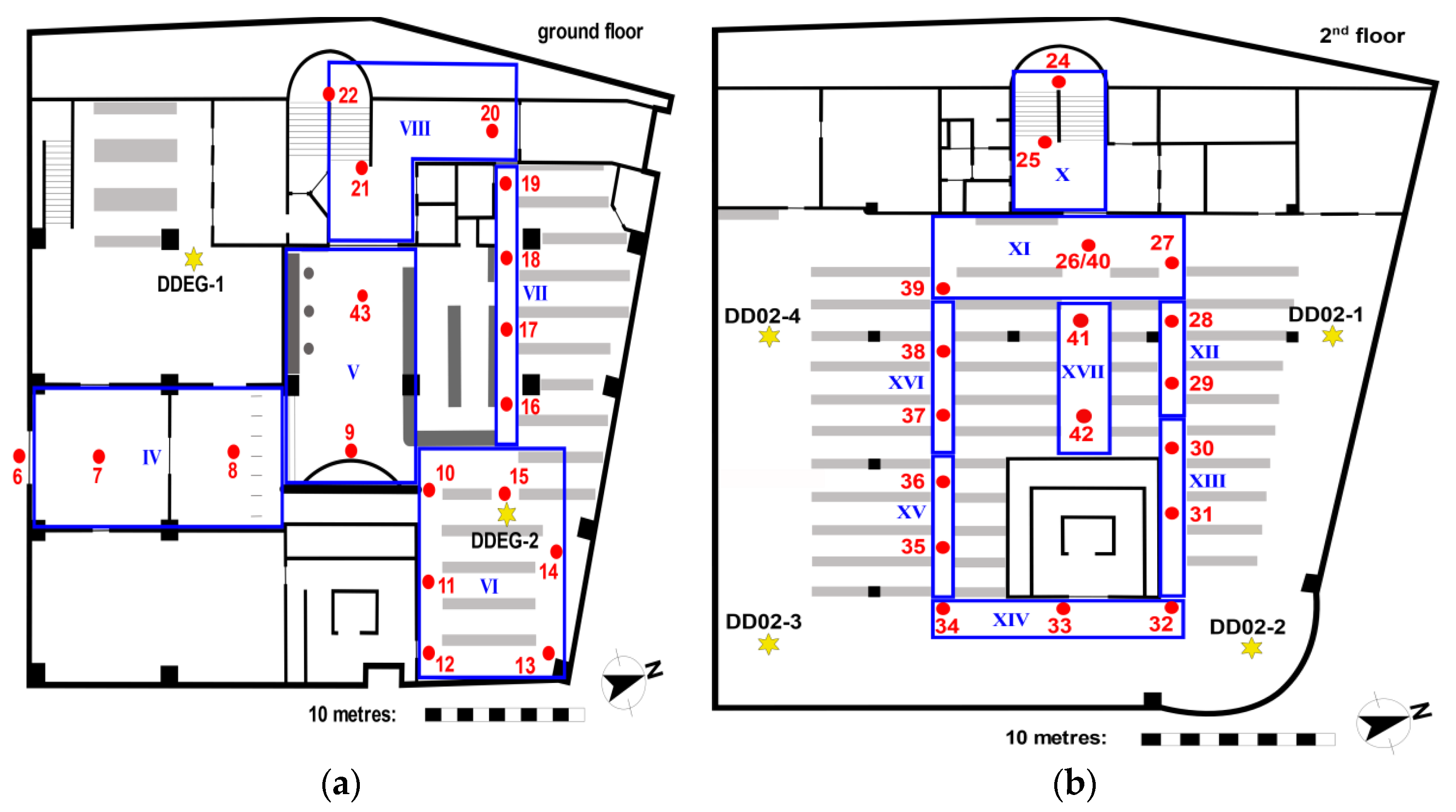
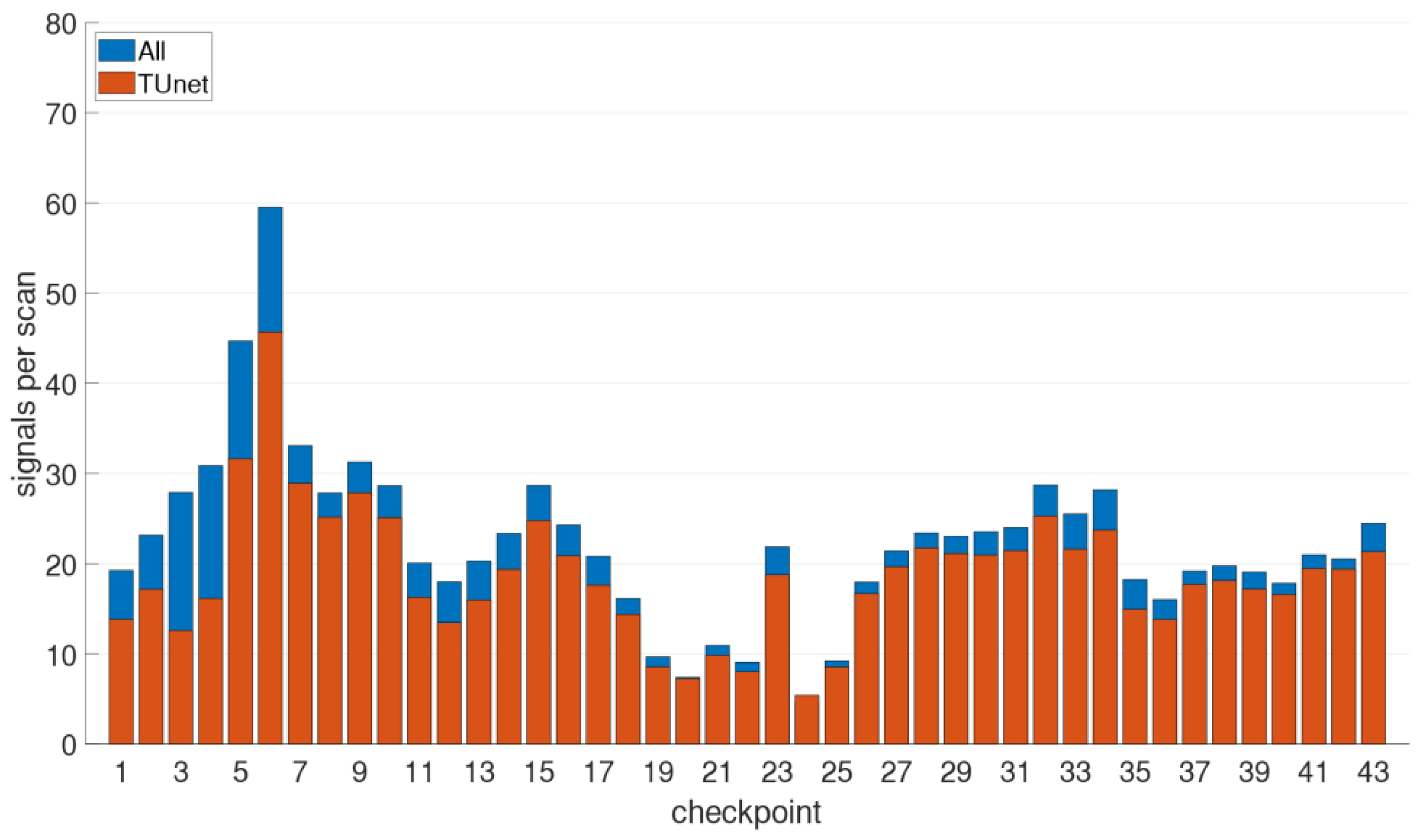
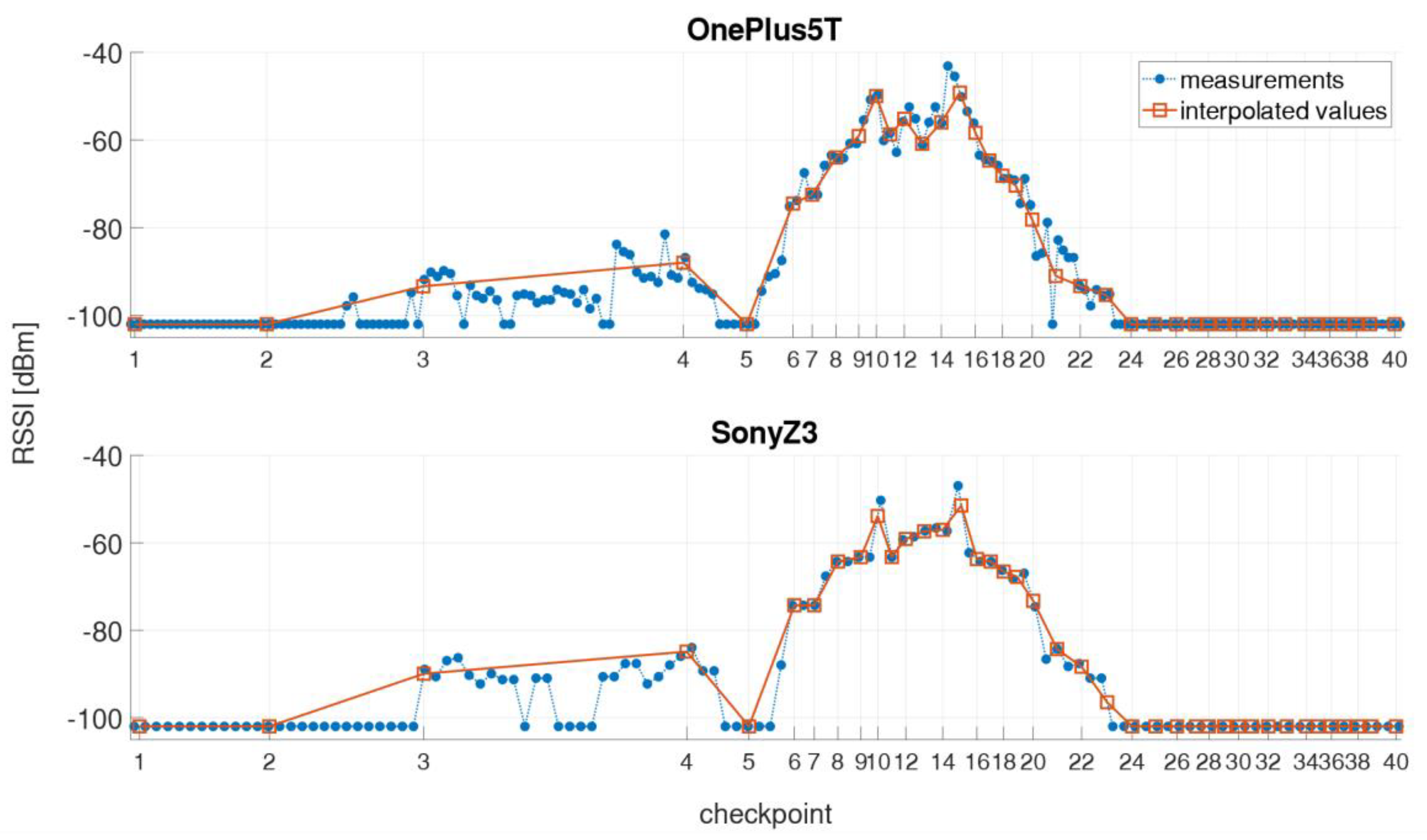
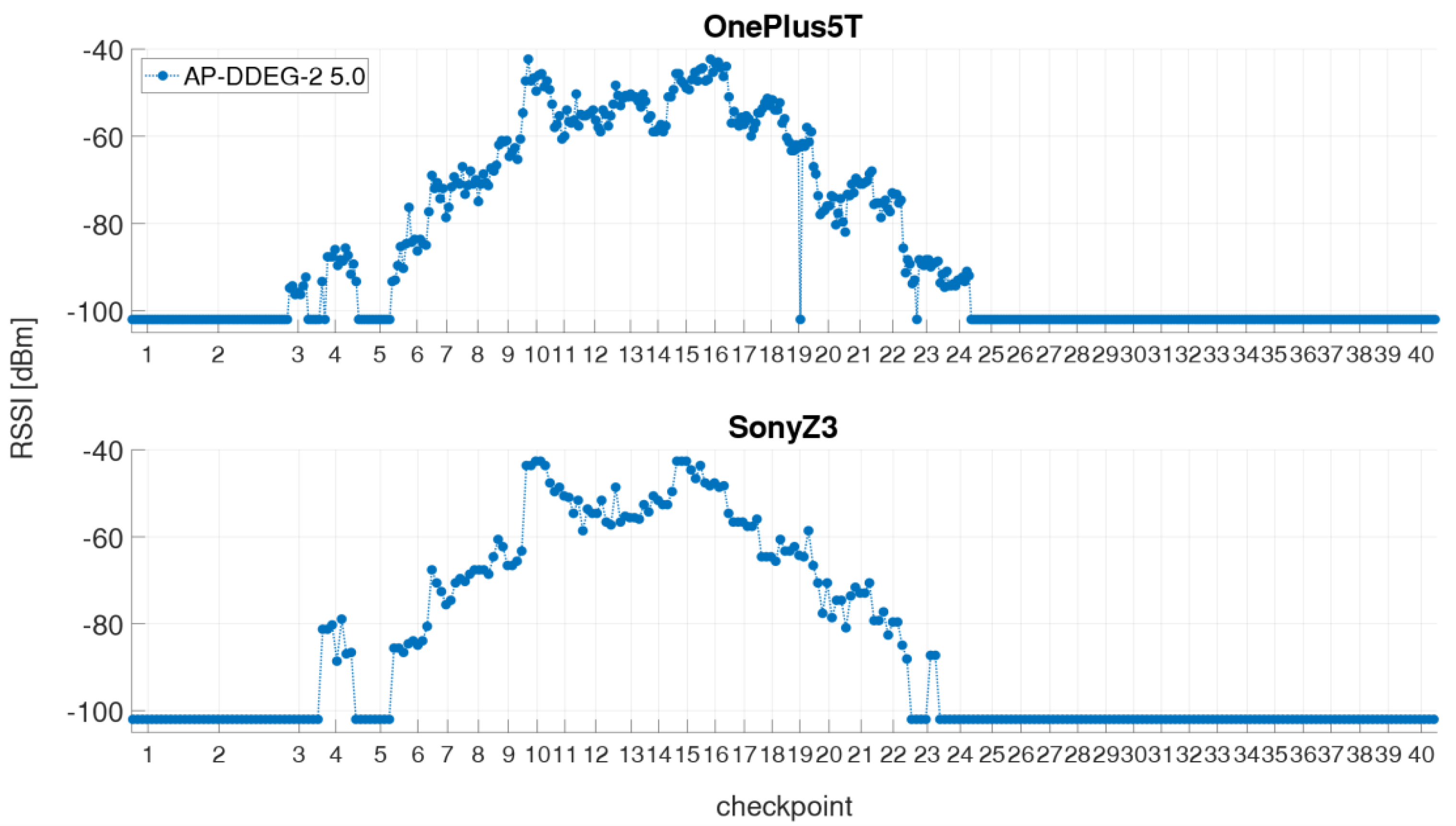
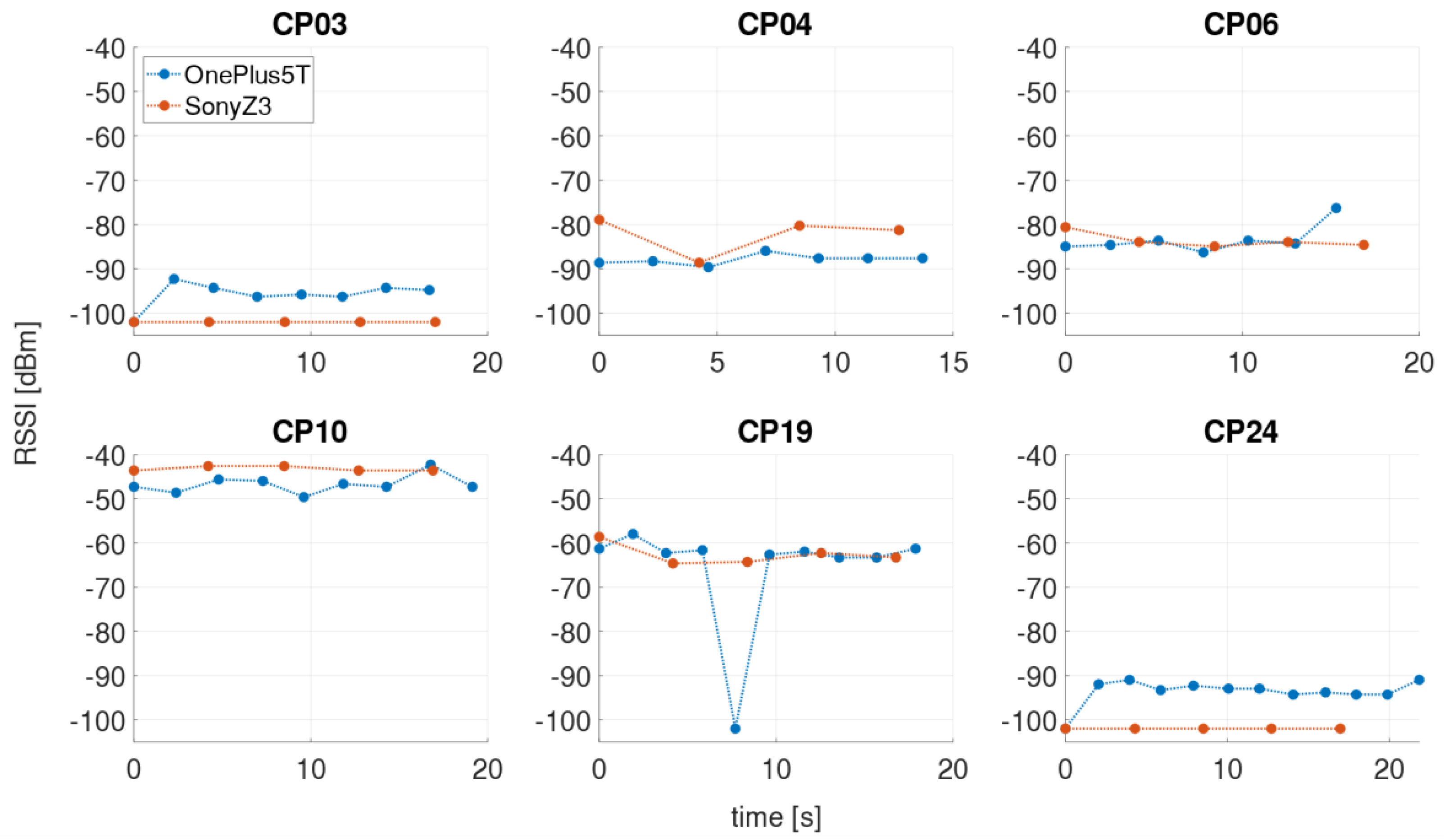
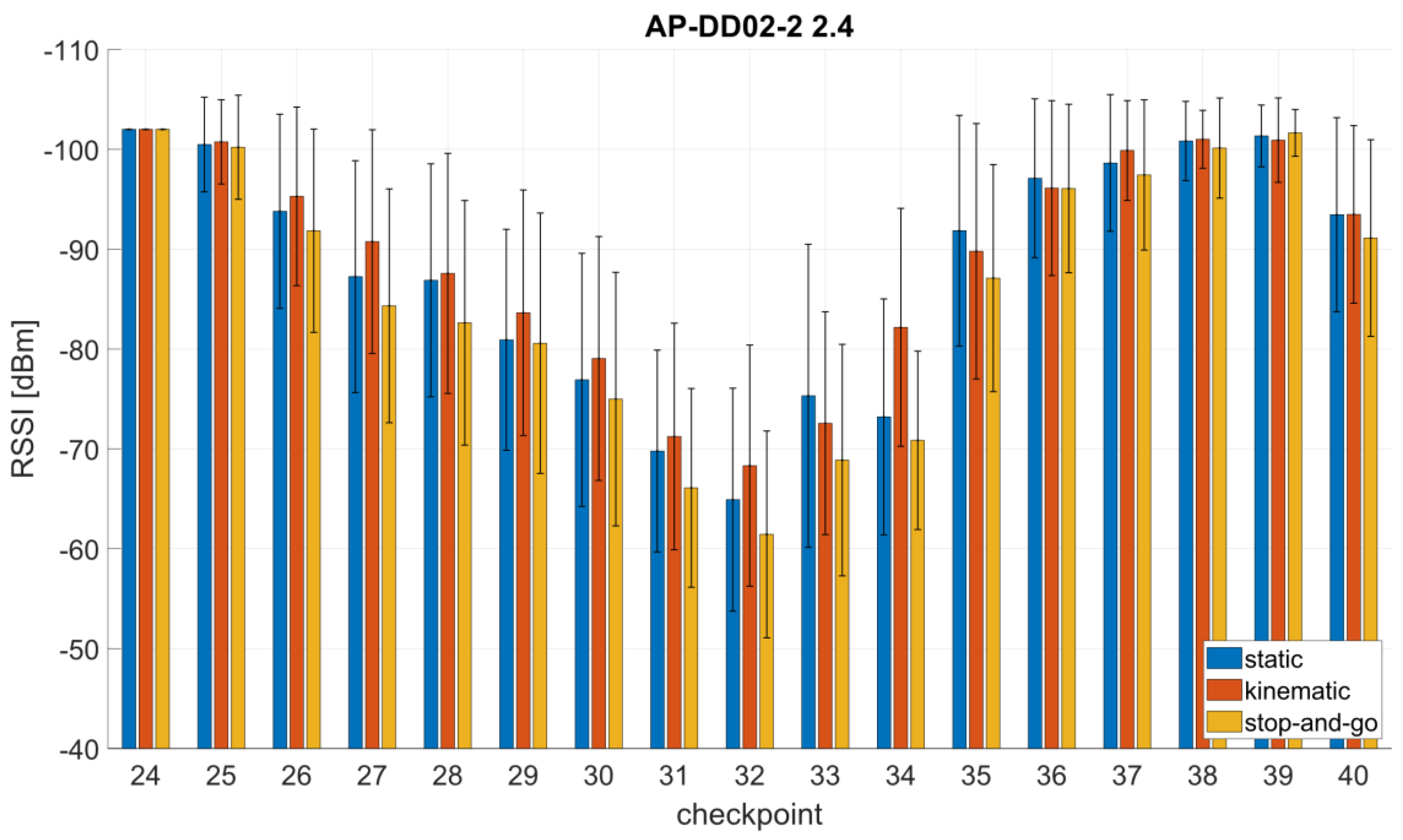

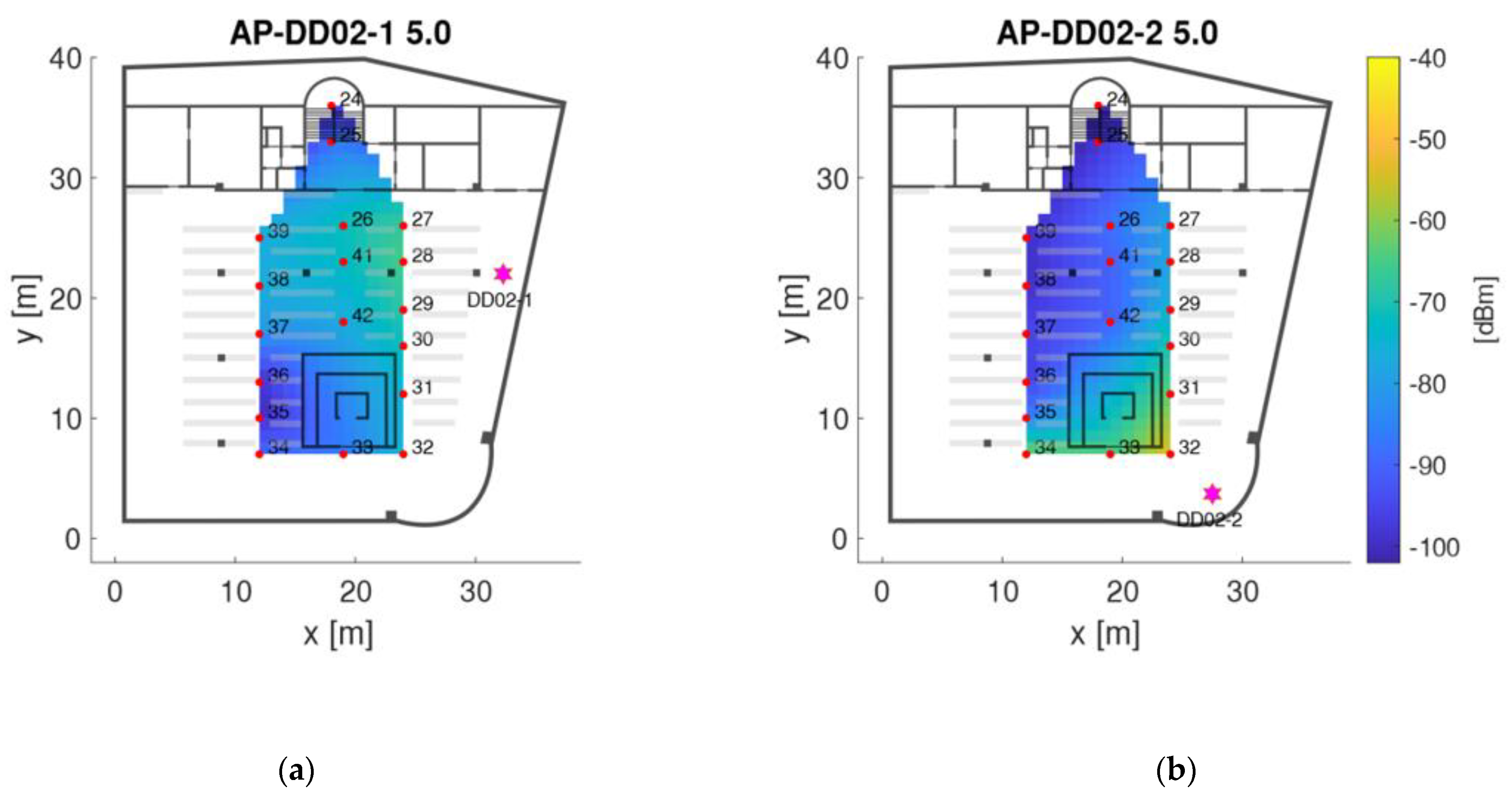
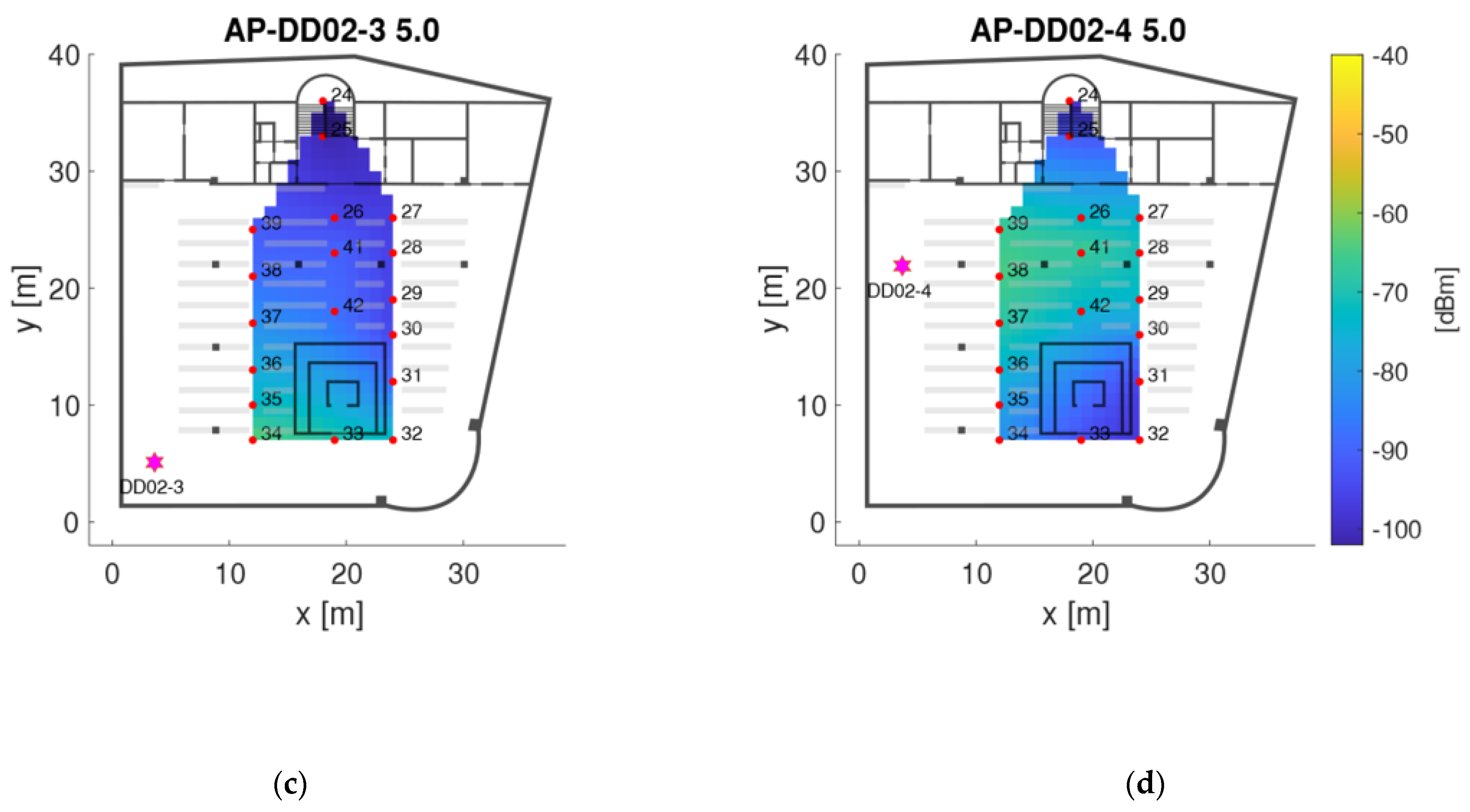
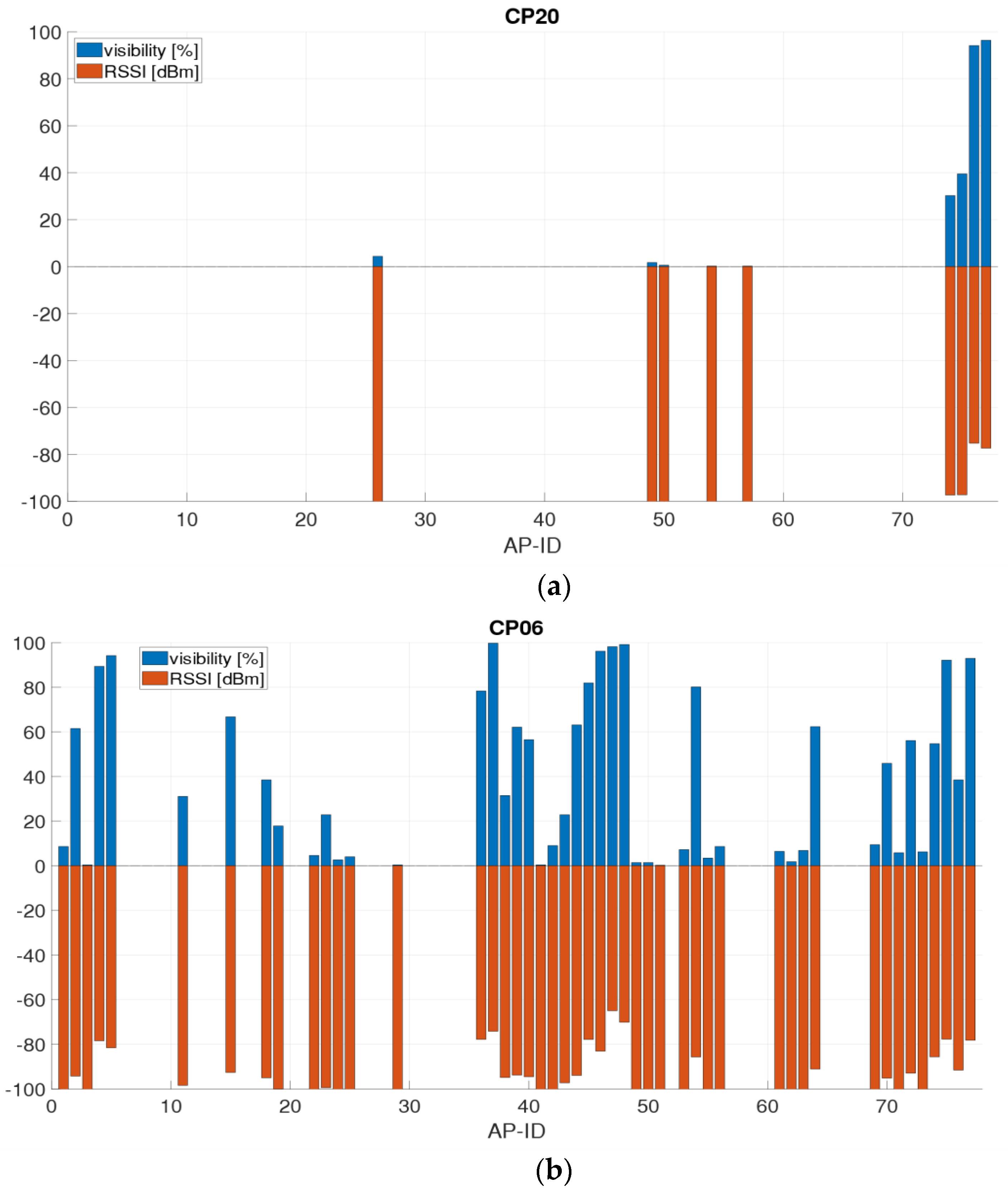
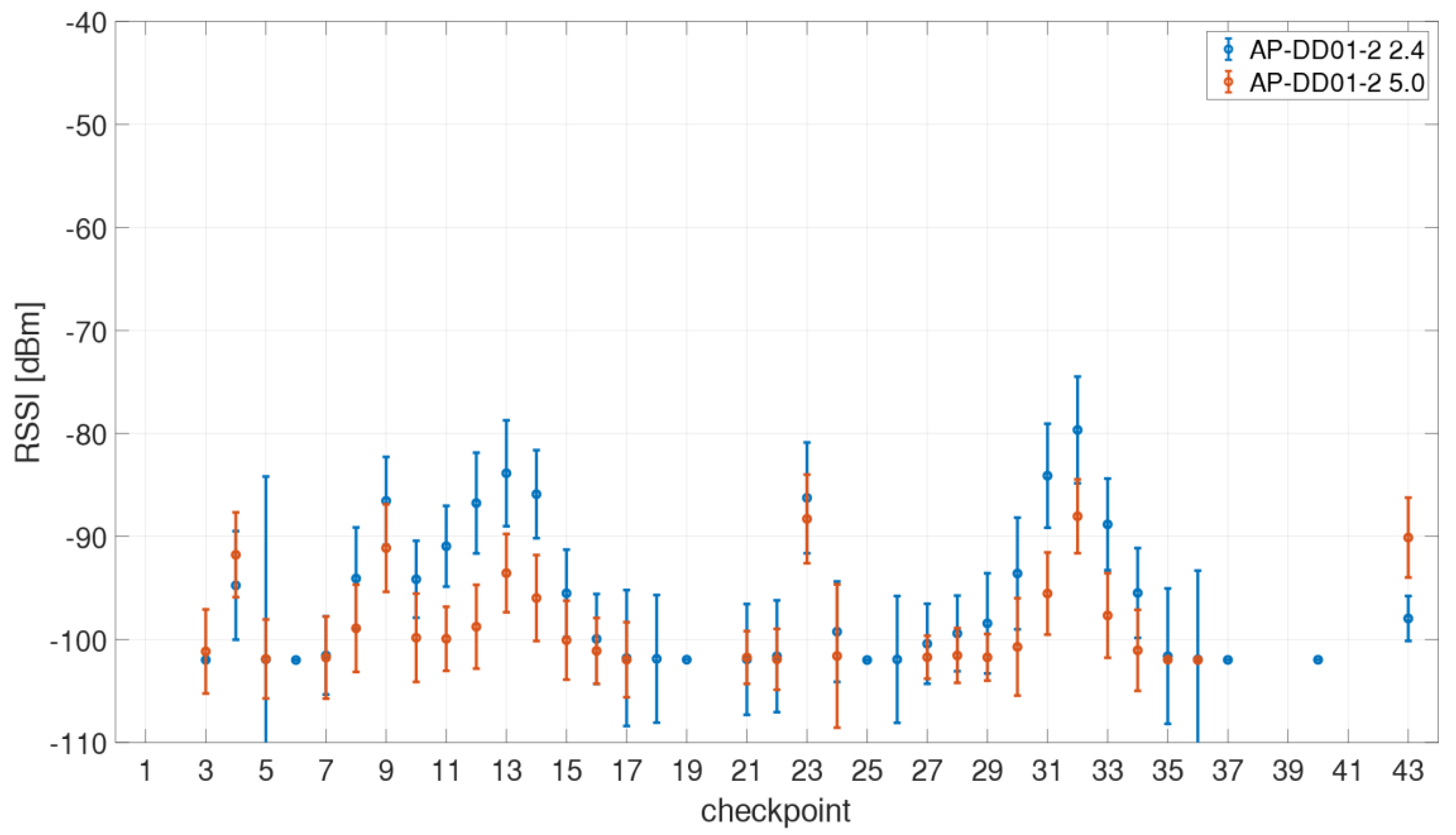

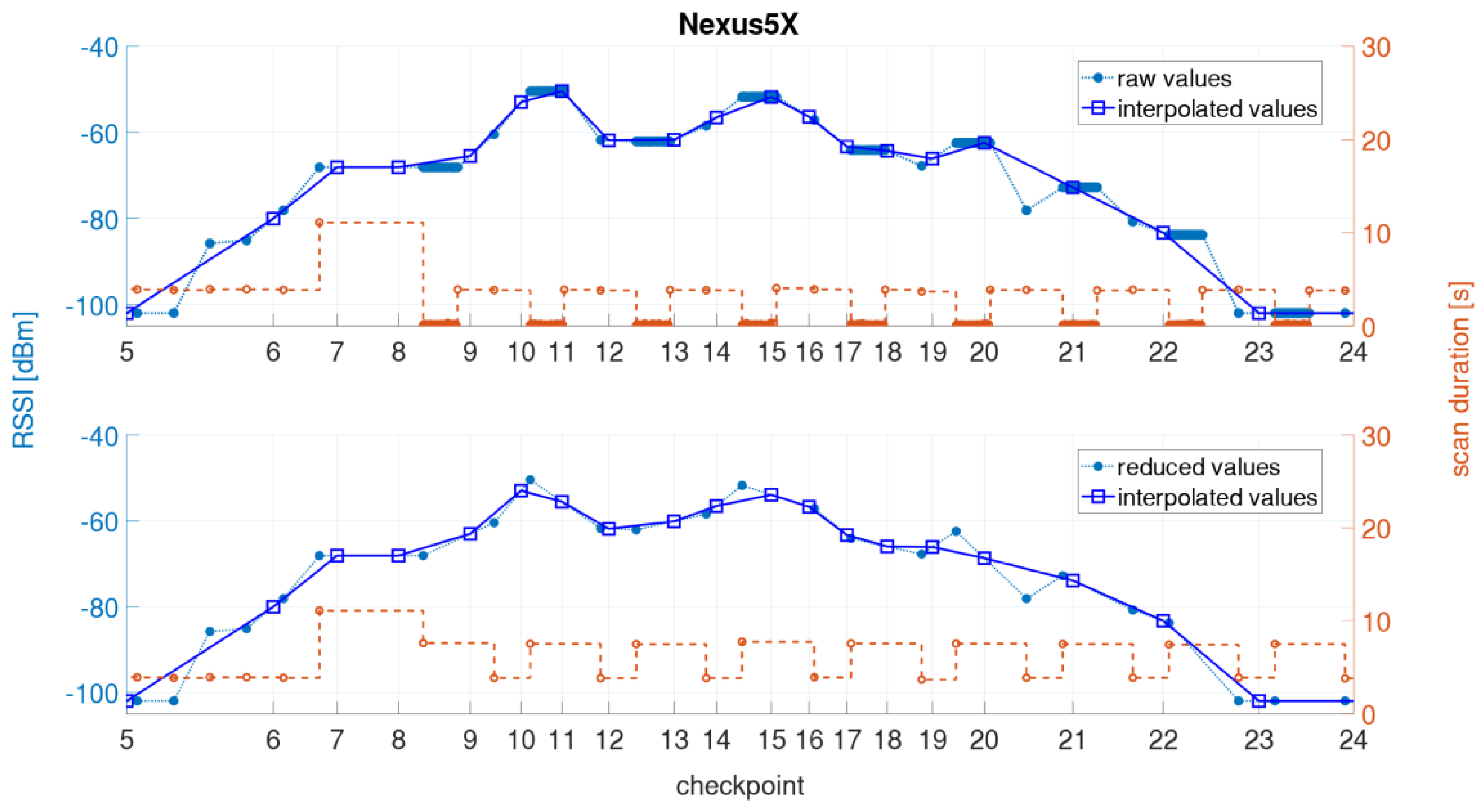
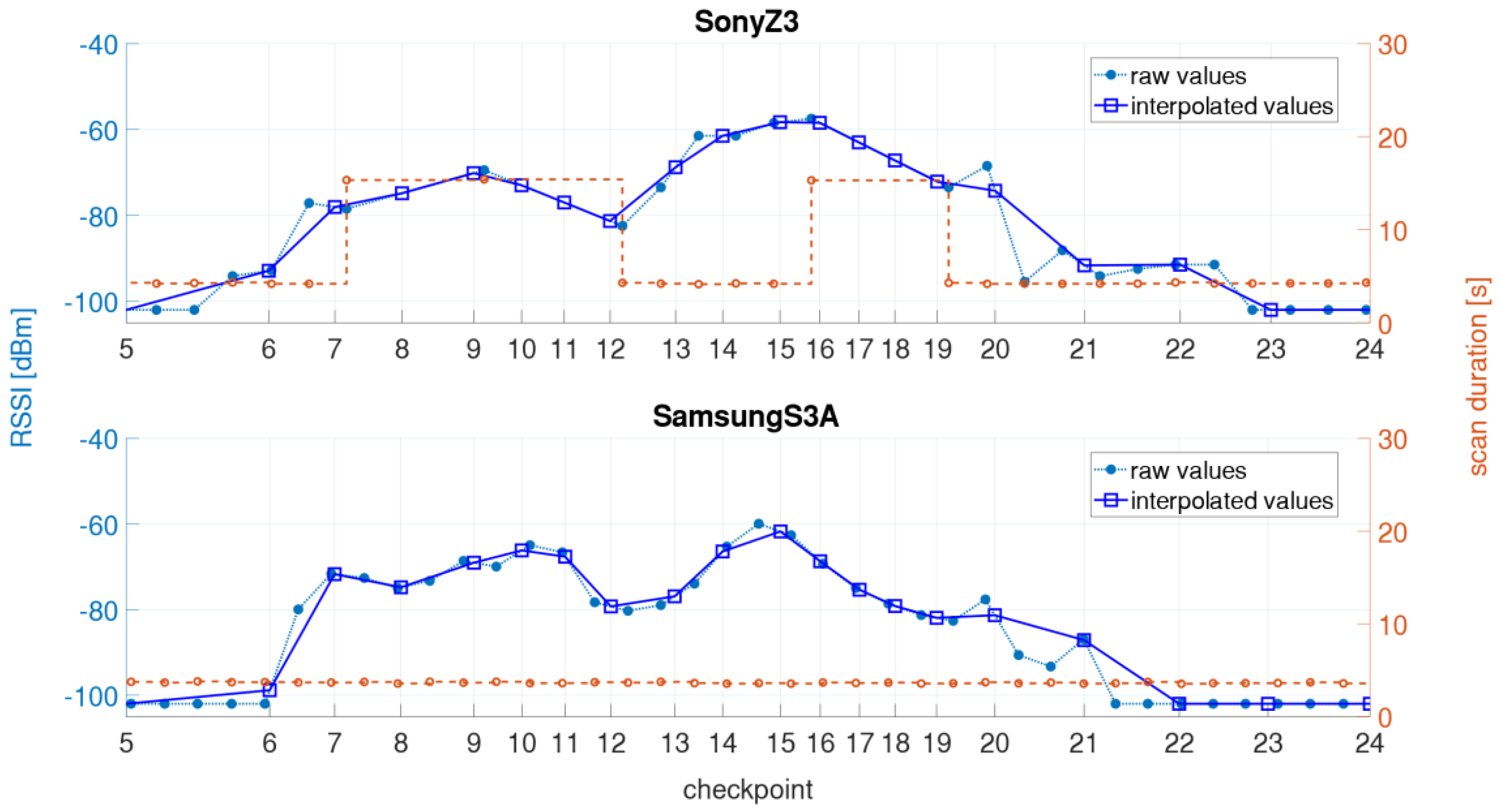
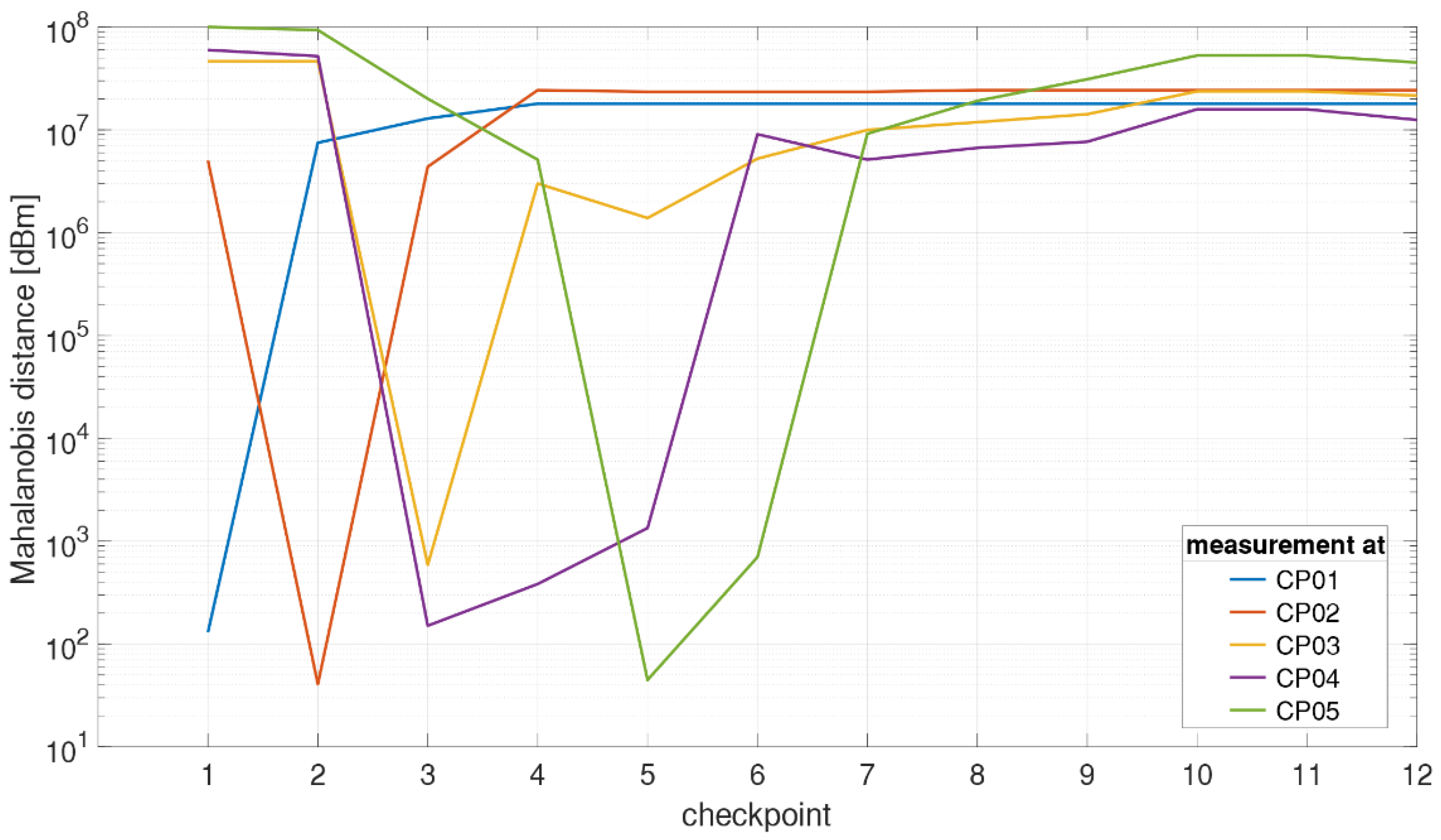

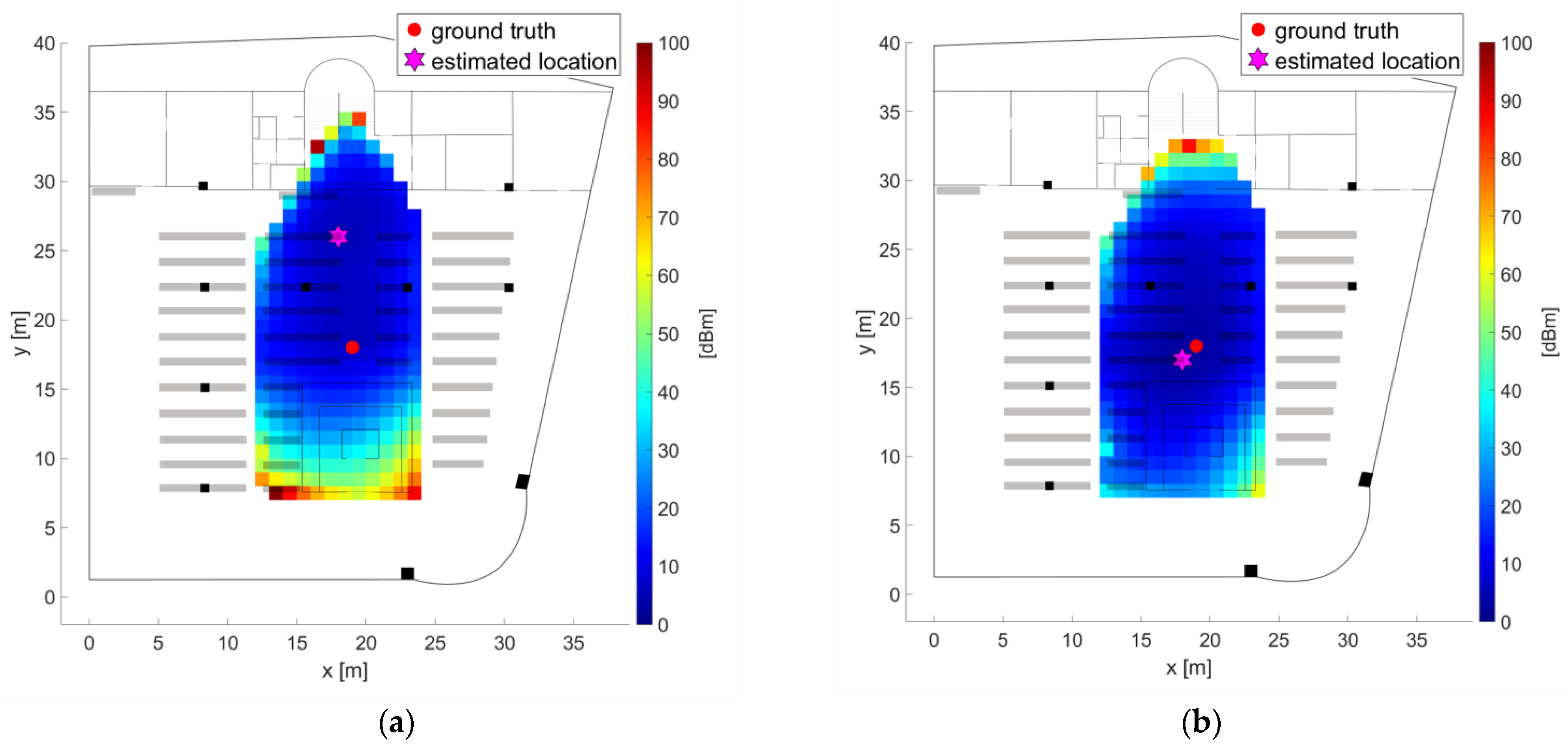
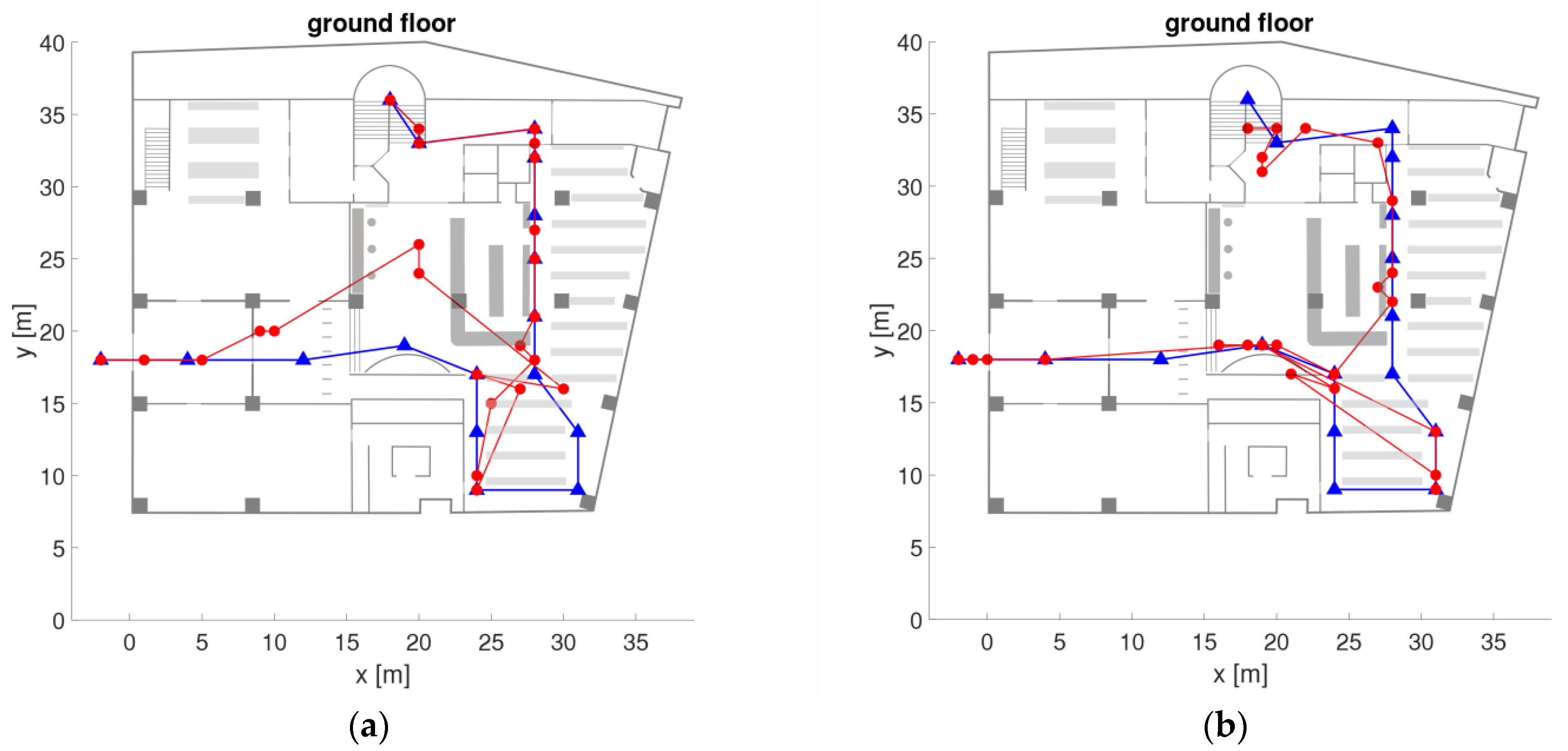
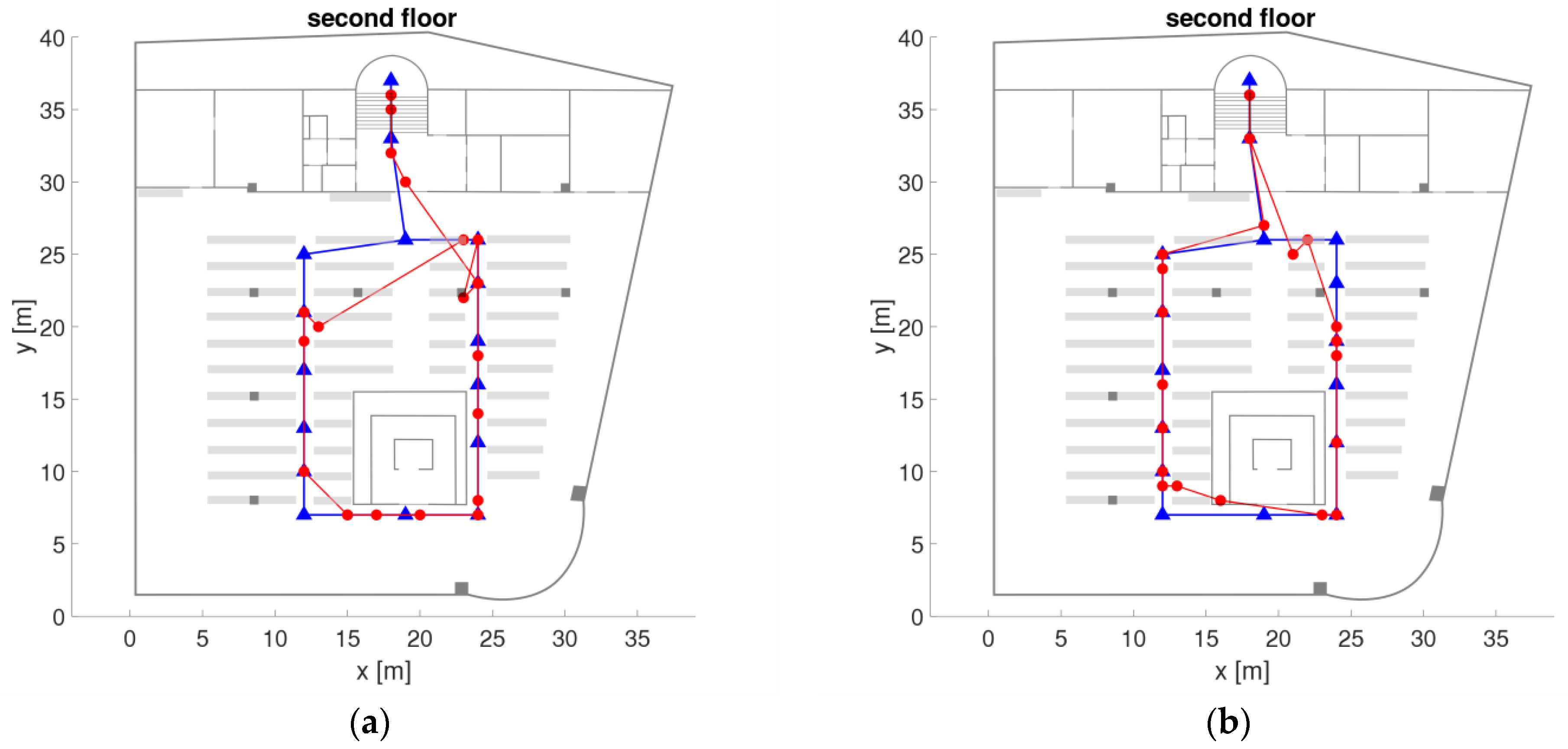
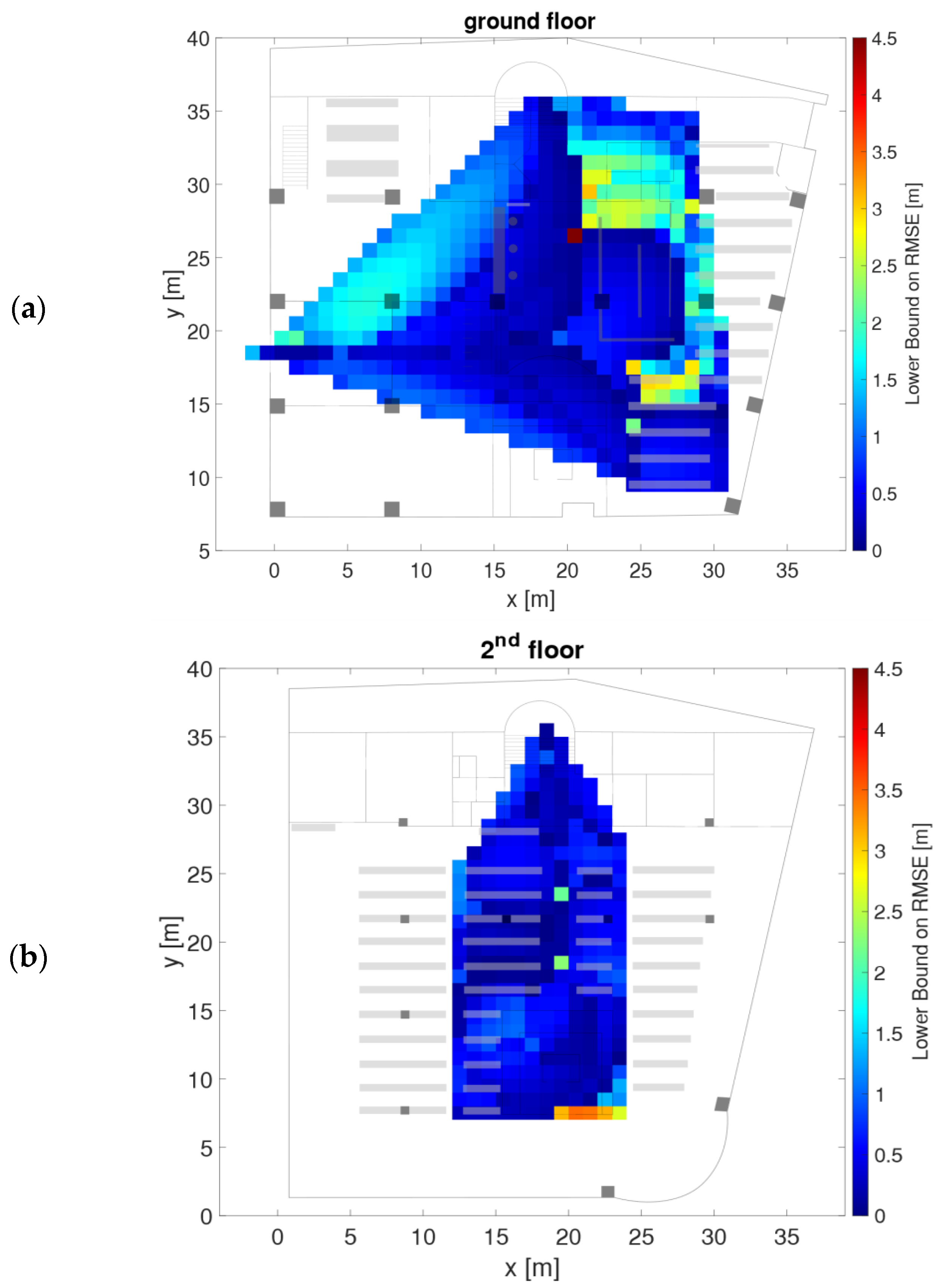
| Technology | Advantages | Disadvantages | Costs | |
|---|---|---|---|---|
| optical | infrared | low power consumption | do not penetrate walls; susceptible to interference; low range | low |
| visible light | low power consumption; high accuracy | do not penetrate walls; susceptible to interference | low | |
| acoustic-based | audible | no costs | disruptive in everyday life | none |
| ultra-sonic | high accuracy | susceptible to interference | medium | |
| radio frequency | Wi-Fi | use of available infrastructure; accuracy on the m-level | susceptible to signal fluctuation; high power consumption | medium |
| Bluetooth | low power consumption | susceptible to signal fluctuation and interference | low | |
| RFID | cheap passive tags can be mounted everywhere | low range and accuracy | medium | |
| UWB | multipath resistant; low energy consumption; high accuracy | expensive hardware | high | |
| magnetic | natural | no costs | susceptible to interference | low |
| artificial | low fluctuations | susceptible to interference | high | |
| smartphonesensors | GNSS | freely available | not useable in buildings | none |
| inertial | work independently | high sensor drift | none | |
| camera | works independently; visual information | computationally high costs | none | |
| Measurement Principle | Advantages | Disadvantages | Positioning Accuracy | |
|---|---|---|---|---|
| CoO | cell-based | simple algorithm | relative positioning to location of transmitter | cell size dependent |
| Lateration | ToA, TDoA, RTT, RSSI-based | no off-line training phase | susceptible to multipath; LoS requirement | dm–m |
| Angulation | AoA | no off-line training phase | susceptible to multipath; LoS requirement; antenna array needed | dm–m |
| Fingerprinting | RSSI | no multipath influence; no LoS requirement | off-line training phase | m |
| Scene Analysis | - | no multipath influence | off-line training phase; high data transfer rates required; computationally intensive | dm–m |
| Dead Reckoning | - | only smartphone sensors used | relative positioning; large drift rates | m |
| ToA | RTT | TDoA | RSSI-Based | |
|---|---|---|---|---|
| signal propagation | does not matter | does not matter | does not matter | matters |
| LoS | required | required | required | not required |
| multipath | matters | matters | matters | partially matters |
| time synchronisation | transmitter and receiver | transmitter and responder | transmitter and receiver | not required |
| positioning accuracy | dm–m | dm | dm–m | m |
| Scan Duration [s] | Average AP Signals per Scan | |
|---|---|---|
| Nexus 5X | 3.8 | 40.8 |
| OnePlus 5T | 2.4 | 42.6 |
| Samsung S3A | 3.5 | 33.7 |
| Samsung S3B | 3.5 | 27.5 |
| Samsung S7 | 2.5 | 39.5 |
| Sony Z3 | 4.1 | 39.3 |
| RSSI | Variances | |||
|---|---|---|---|---|
| [dBm] | [dBm] | |||
| static—kinematic | 0.96 | 0.3 | 0.93 | 3.9 |
| static—stop-and-go | 0.99 | 0.3 | 0.97 | 2.8 |
| kinematic—stop-and-go | 0.96 | 0.4 | 0.94 | 3.4 |
| Outdoor | |
| Ground floor | |
| 1st floor | |
| 2nd floor |
| Cell | Checkpoints | Location | MSR |
|---|---|---|---|
| I | 1, 2 | outdoor 1 | 100.0% |
| II | 3, 4 | outdoor 2 | 100.0% |
| III | 5, 6 | entrance area (outdoor) | 100.0% |
| IV | 7, 8 | entrance area (indoor) | 66.7% |
| V | 9, 43 | ground floor lobby | 87.5% |
| VI | 10–15 | ground floor area 1 | 56.9% |
| VII | 16–19 | ground floor area 2 | 54.2% |
| VIII | 20–22 | ground floor staircase | 77.8% |
| IX | 23 | first floor staircase | 100.0% |
| X | 24, 25 | second floor staircase | 50.0% |
| XI | 26, 27, 39, 40 | second floor area 1 | 39.6% |
| XII | 28, 29 | second floor area 2 | 91.7% |
| XIII | 30, 31 | second floor area 3 | 66.7% |
| XIV | 32–34 | second floor area 4 | 100.0% |
| XV | 35, 36 | second floor area 5 | 70.8% |
| XVI | 37, 38 | second floor area 6 | 87.5% |
| XVII | 41, 42 | second floor area 7 | 66.7% |
| Smartphone | Orientation | Mean | Median | Standard Deviation |
|---|---|---|---|---|
| Nexus 5X | 1 | 4.2 | 3.0 | 4.0 |
| 2 | 3.1 | 2.2 | 2.6 | |
| OnePlus 5T | 1 | 3.5 | 3.0 | 3.5 |
| 2 | 3.1 | 2.0 | 4.1 | |
| Samsung S3A | 1 | 1.8 | 1.0 | 2.3 |
| 2 | 2.1 | 1.0 | 3.6 | |
| Samsung S3B | 1 | 2.6 | 1.0 | 3.8 |
| 2 | 2.9 | 1.0 | 4.4 | |
| Samsung S7 | 1 | 3.3 | 2.2 | 3.4 |
| 2 | 2.8 | 1.4 | 3.1 | |
| Sony Z3 | 1 | 3.1 | 2.0 | 6.4 |
| 2 | 2.1 | 1.0 | 4.2 |
| Smartphone | CP Start-End | Mean | Median | Standard Deviation |
|---|---|---|---|---|
| Nexus 5X | 1-40 | 3.0 | 2.1 | 3.0 |
| 40-1 | 2.9 | 2.2 | 2.7 | |
| OnePlus 5T | 1-40 | 2.1 | 1.0 | 2.4 |
| 40-1 | 1.9 | 1.0 | 2.7 | |
| Samsung S3A | 1-40 | 1.6 | 1.0 | 2.3 |
| 40-1 | 3.3 | 2.0 | 3.7 | |
| Samsung S3B | 1-40 | 2.2 | 1.0 | 4.5 |
| 40-1 | 2.9 | 1.0 | 5.0 | |
| Samsung S7 | 1-40 | 2.7 | 1.5 | 3.1 |
| 40-1 | 2.0 | 1.0 | 2.4 | |
| Sony Z3 | 1-40 | 4.3 | 3.6 | 5.2 |
| 40-1 | 3.9 | 3.0 | 3.9 |
Publisher’s Note: MDPI stays neutral with regard to jurisdictional claims in published maps and institutional affiliations. |
© 2021 by the authors. Licensee MDPI, Basel, Switzerland. This article is an open access article distributed under the terms and conditions of the Creative Commons Attribution (CC BY) license (http://creativecommons.org/licenses/by/4.0/).
Share and Cite
Retscher, G.; Leb, A. Development of a Smartphone-Based University Library Navigation and Information Service Employing Wi-Fi Location Fingerprinting. Sensors 2021, 21, 432. https://doi.org/10.3390/s21020432
Retscher G, Leb A. Development of a Smartphone-Based University Library Navigation and Information Service Employing Wi-Fi Location Fingerprinting. Sensors. 2021; 21(2):432. https://doi.org/10.3390/s21020432
Chicago/Turabian StyleRetscher, Guenther, and Alexander Leb. 2021. "Development of a Smartphone-Based University Library Navigation and Information Service Employing Wi-Fi Location Fingerprinting" Sensors 21, no. 2: 432. https://doi.org/10.3390/s21020432
APA StyleRetscher, G., & Leb, A. (2021). Development of a Smartphone-Based University Library Navigation and Information Service Employing Wi-Fi Location Fingerprinting. Sensors, 21(2), 432. https://doi.org/10.3390/s21020432





